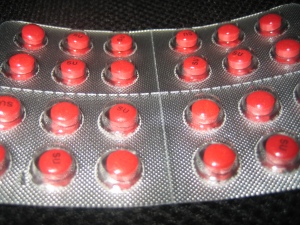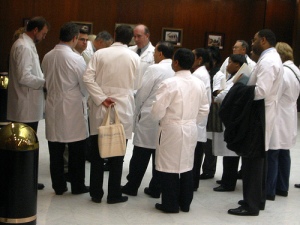There is continued debate over whether governments have the right to fortify our foods and drinking water with vitamins and minerals as a public health strategy, in order to address a health problem.
Have we become a ‘nanny’ state, where governments have to make decisions regarding our diet for us, that we apparently no longer able to make for ourselves?

Call to add fluoride to bottled water
Fluoride
Take the case of fluoride added to our drinking water. According to the Victorian Department of Health’s Chief Health Officer,
Water fluoridation helps protect teeth against decay, and is the most effective way of allowing everybody access to the benefits of fluoride. Scientific studies have shown that water fluoridation is a safe and effective way to reduce tooth decay, even though there is widespread use of fluoridated toothpaste.
Earlier this year, there were calls for fluoride to be added to bottled water. Does this remove our right to chose what we put into our bodies?
The debate continues with the use of fortified foods, such Vitamin D, Iodine and folate.
Vitamin D
Studies indicate that Australians suffer from Vitamin D deficiency. While most Vitamin D should be obtained from exposure to the sun, which presumably is readily available in Australia, certain food sources contain significant amounts of vitamin D.
Rich sources are fish, especially fish with a high fat content, such as sardines, salmon, herring and mackerel. Other sources of importance are meat, milk and eggs, and fortified foods such as margarine.
In Australia, there is mandatory Vitamin D fortification of table edible oil spreads (eg, low-fat spreads) and table margarine, and voluntary fortification of modified and skim milks, and powdered milk, yoghurt and table confections (eg, Frûche dairy products) and cheese.
While the United States fortifies a large variety of foods, the fortification levels and range in Europe is very low.

Iodine now mandatory addition to bread
Iodine
And now, Iodine is on the hit list as an added extra in our foods. In fact, it has now become mandatory to fortify the bread in Australia with iodine. While iodine can be an important factor in the development of newborn babies, the AMA concedes that,
Although we haven’t seen any large numbers of babies born who are severely iodine deficient over the years, it’s the subtle changes that are important, … anything that we can do that gives babies the best chance and the best start in life is really worth doing
So is adding things into our food and water for the good of those that are not able to make wise choices for themselves? Some of the commentary on response to the iodine article include:
It has to be pointed out that a healthy, balanced diet will provide sufficient Iodine in most cases. We can’t just keep shoving stuff in bread and water to make up for people’s poor dietary choices. (Ford: 09 Oct 2009 10:44:34am)
Yet the point of the article was that iodine levels in the average population are deficient, so there goes that statement. So the alternative is let the people get sick, afterall it is their own fault, resulting in more pressure to our already overtaxed health system when those people get sick. Brilliant idea – NOT. (lopati: 09 Oct 2009 11:13:04am)
That’s not true, particularly in Australia. You could be eating a ‘healthy’ diet of home grown fruit and vegetables in many places (like Tasmania, Canberra, Adelaide Hills to name a few) and not getting sufficient iodine because it is deficient in the soil. If you were also avoiding salt (because it is linked with increased blood pressure) or not using iodised salt it would be easy to become iodine deficient. (luke warm: 09 Oct 2009 12:21:31pm)
Iodised salt can be bought anywhere, however some people are affected by too much iodine…so it is unfair to force this onto the public! If you need iodine, ask your doctor what the side effects of overdosing will be and how it works with any medications! You don’t know all the additives in food that can cause so many problems. (Pat Johnson: 09 Oct 2009 10:59:42am)
According to Australia’s Policy Guideline – Fortification of Food with Vitamins and Minerals, the mandatory addition of vitamins and minerals will only occur if there has been a demonstrated significant health problem and that the additives do not result in detrimental excesses or imbalances in the intake of the general population.
What but does this mean for those who would suffer ‘detrimental’ excesses? According to Deakin University’s Adjunct Professor Joe Lederman,
Australian consumers should have the right to claim for compensation if they are adversely affected by food which has been fortified with additives by Government mandate
Folate
He said while that attempts to encourage pregnant women to increase their folate intake through folic acid supplements and voluntary fortification of certain foods with folic acid, had resulted in a 30 per cent decrease in neural tube defects among non-indigenous infants, there was no change in the rates of these defects in indigenous Australian infants.
He also claimed that the mandatory fortification meant that,
Australians would be exposed to significantly raised levels of synthetic folic acid (that) …might cause serious illness or mask other serious health conditions.
He concluded that this mandatory fortification should be accompanied by a legal right to compensation should it result in ill-health in the future.
Perhaps education regarding good diet should go hand-in-hand with the availability of fortified and non-fortified foods (and water), giving consumers the ultimate right to chose and the responsibility of what is right for their bodies.







